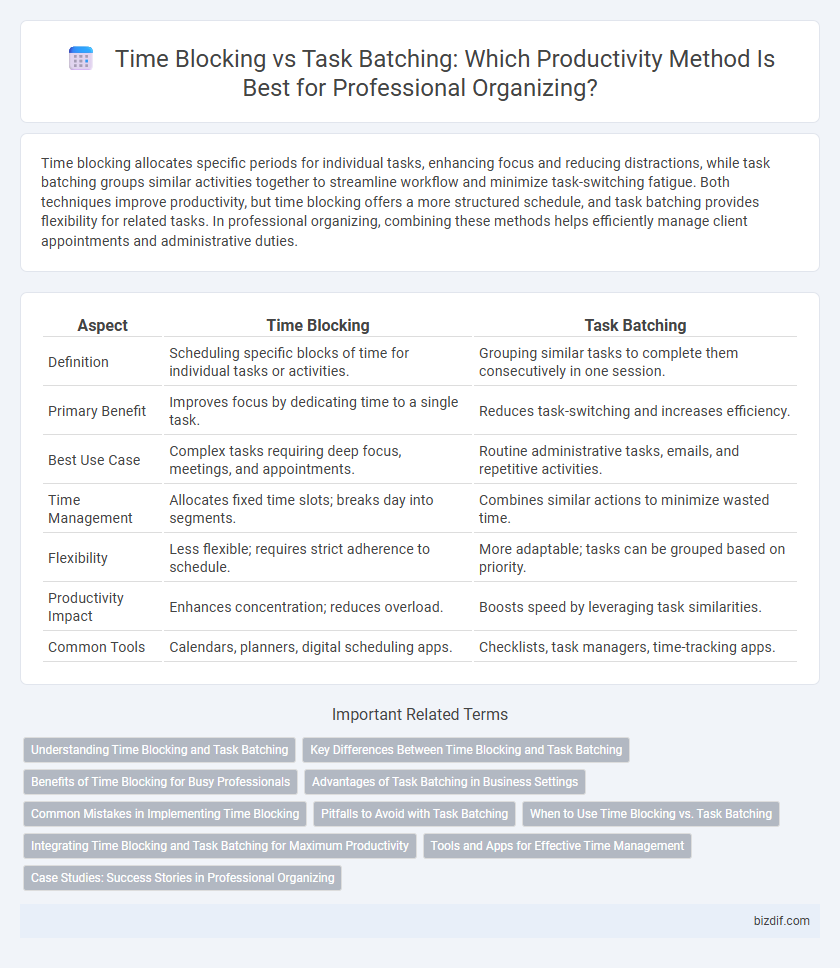Time blocking allocates specific periods for individual tasks, enhancing focus and reducing distractions, while task batching groups similar activities together to streamline workflow and minimize task-switching fatigue. Both techniques improve productivity, but time blocking offers a more structured schedule, and task batching provides flexibility for related tasks. In professional organizing, combining these methods helps efficiently manage client appointments and administrative duties.
Table of Comparison
| Aspect | Time Blocking | Task Batching |
|---|---|---|
| Definition | Scheduling specific blocks of time for individual tasks or activities. | Grouping similar tasks to complete them consecutively in one session. |
| Primary Benefit | Improves focus by dedicating time to a single task. | Reduces task-switching and increases efficiency. |
| Best Use Case | Complex tasks requiring deep focus, meetings, and appointments. | Routine administrative tasks, emails, and repetitive activities. |
| Time Management | Allocates fixed time slots; breaks day into segments. | Combines similar actions to minimize wasted time. |
| Flexibility | Less flexible; requires strict adherence to schedule. | More adaptable; tasks can be grouped based on priority. |
| Productivity Impact | Enhances concentration; reduces overload. | Boosts speed by leveraging task similarities. |
| Common Tools | Calendars, planners, digital scheduling apps. | Checklists, task managers, time-tracking apps. |
Understanding Time Blocking and Task Batching
Time blocking allocates specific time segments for individual tasks, enhancing focus by minimizing distractions, while task batching groups similar activities to streamline workflow and reduce task-switching. Both techniques improve productivity by structuring time efficiently, but time blocking emphasizes scheduled intervals, whereas task batching centers on handling related tasks consecutively. Understanding these methods helps professionals optimize their schedules to increase efficiency and maintain sustained concentration.
Key Differences Between Time Blocking and Task Batching
Time blocking schedules specific tasks within fixed time slots on a calendar, enhancing focus by minimizing distractions during set periods. Task batching groups similar activities together to complete them in one extended session, reducing transition time and improving efficiency. The key difference lies in time blocking's emphasis on allocating precise intervals for diverse tasks, while task batching prioritizes execution of related tasks collectively to leverage cognitive momentum.
Benefits of Time Blocking for Busy Professionals
Time blocking enhances productivity by allocating specific time periods for individual tasks, reducing distractions and decision fatigue for busy professionals. This method supports better task prioritization, ensuring critical projects receive dedicated focus and deadlines are met consistently. By structuring the workday into focused intervals, time blocking helps maintain energy levels and prevents burnout, leading to improved overall work-life balance.
Advantages of Task Batching in Business Settings
Task batching enhances productivity by grouping similar tasks to minimize context switching and reduce cognitive load, leading to more efficient use of work hours. This method streamlines workflow in business settings, promoting deeper focus and faster completion rates on administrative duties, communications, and repetitive tasks. Companies employing task batching report improved project management, higher employee satisfaction, and noticeable reductions in operational delays.
Common Mistakes in Implementing Time Blocking
Common mistakes in implementing time blocking include underestimating task duration, leading to overcrowded schedules that decrease productivity. Many professionals fail to account for necessary breaks, causing burnout and reduced focus during blocked periods. Overemphasis on rigid time slots without flexibility can result in missed priorities and increased stress.
Pitfalls to Avoid with Task Batching
Task batching can lead to diminished focus if unrelated or complex tasks are grouped together, causing mental fatigue and reduced productivity. It's essential to avoid overloading batches with diverse activities that require different cognitive skills, as this disrupts workflow and increases switching costs. Prioritizing similar tasks with consistent thinking patterns ensures efficient time use and minimizes the pitfalls of task batching in professional organizing.
When to Use Time Blocking vs. Task Batching
Use time blocking when managing diverse projects requiring dedicated focus on specific time intervals to enhance productivity and reduce distractions. Task batching is ideal for grouping similar repetitive tasks to streamline workflow, minimize transition time, and improve efficiency. Combining both methods can optimize time management by allocating broad focus periods and concentrating repetitive activities within those blocks.
Integrating Time Blocking and Task Batching for Maximum Productivity
Integrating time blocking and task batching enhances productivity by allocating specific time periods for grouped tasks, minimizing distractions and transition time. Time blocking sets a schedule for focused work intervals, while task batching groups similar activities to streamline effort and reduce cognitive switching. Combining these strategies creates a structured workflow that maximizes efficiency and helps maintain sustained attention on related tasks throughout the day.
Tools and Apps for Effective Time Management
Time blocking and task batching both enhance productivity by structuring schedules, with time blocking using calendar apps like Google Calendar or Outlook to allocate specific periods for tasks, while task batching leverages tools such as Trello or Asana to group similar tasks for streamlined execution. Digital timers like Pomodoro apps boost focus by breaking work into intervals, complementing both methods. Integration of these tools enables precise planning and efficient task completion, maximizing professional organizing outcomes.
Case Studies: Success Stories in Professional Organizing
Case studies in professional organizing reveal that time blocking enhances productivity by allocating specific hours for focused work, minimizing distractions. Task batching, on the other hand, groups similar tasks to streamline workflow and reduce task-switching costs, proven to increase efficiency in complex projects. Successful implementations often combine both strategies, tailored to individual client needs, resulting in measurable gains in time management and reduced stress levels.
time blocking vs task batching Infographic

 bizdif.com
bizdif.com